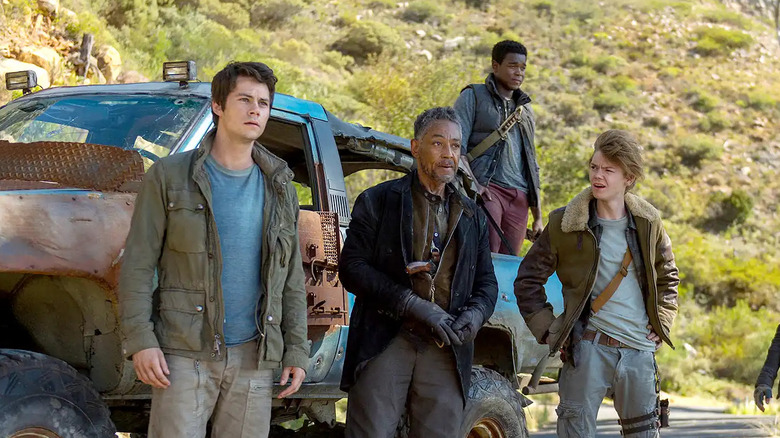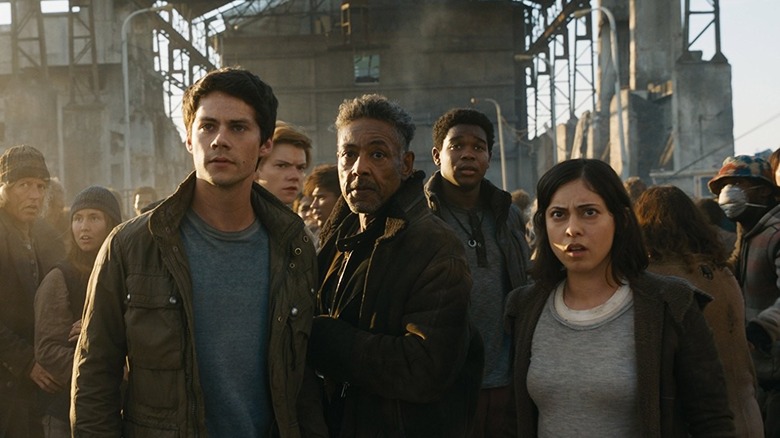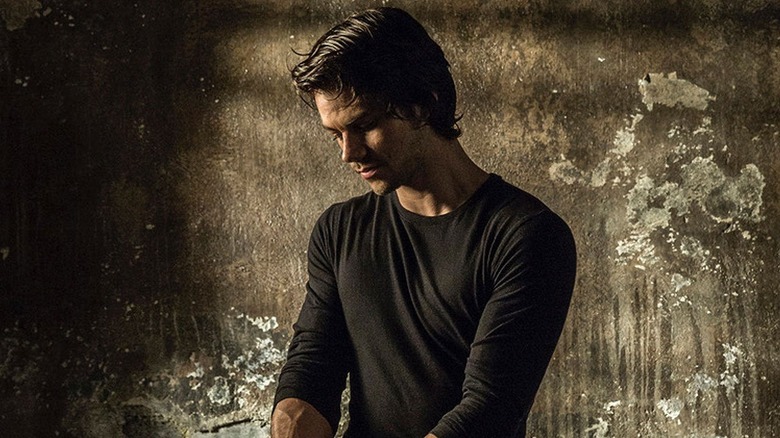How An On-Set Accident Nearly Ended Dylan O'Brien's Career (And What Came Next)
"The Maze Runner" series is a trilogy of films based on the James Dashner novels of the same names ("The Maze Runner" and "The Scorch Trials" and "The Death Cure," respectively"). In broad strokes, the story follows a group of children struggling to survive vicious experimentation at the hands of evil scientists in a post-apocalyptic America. Without spoiling too much, there's a murderous labyrinth infested by ... robot spider things, a zombie-adjacent virus culling the human population with savage accuracy, and global weather crises brought upon by catastrophic solar flares. If that sounds like a lot, that's because it is: Dashner piles his character under the titanic weight of tragedy.
And the movies reflect that, if not in a page-perfect onscreen depiction, then at least in spirit. The artistic team physically created a great portion of the first film's titular maze, and at no point during the cinematic trilogy did the Gladers (Dashner's in-canon name for the kids) catch a well-deserved break. That went doubly so for Dylan O'Brien, who starred as the series' protagonist, Thomas. For those who need a quick refresher, Thomas was a child scientist who wiped his own memory so that he could jump into the very trap he partially built. Ultimately, he led his fellow Gladers — or at least most of them — to freedom. That path involved harrowing feats of bravery and heroism that nearly cost Thomas his life and, on one disastrous occasion, nearly cost O'Brien his life, too.
Stunts are very, very dangerous
In March 2016, on the set of the third and final installment in the "Maze Runner" trilogy, "The Death Cure," Dylan O'Brien was involved in an accident while performing a stunt involving motorized vehicles. The Hollywood Reporter reported that O'Brien was strapped into a safety harness while riding atop a moving vehicle when, suddenly, he was pulled to the ground. That alone would be enough to cause harm ... but O'Brien fell into the path of another moving vehicle. The Salt Lake Tribune described the second vehicle as a "motorcycle sliding out of control."
O'Brien's subsequent injuries were extensive. He told the Salt Lake Tribune that the accident "broke most of the right side of [his] face" so completely that he required facial reconstruction surgery, not just for aesthetics (which would have been enough justification on its own) but to reconstitute standard function. To better contextualize this, the damage ran so deep as to inflict brain trauma.
The ensuing surgery, which successfully patched O'Brien back together, left him with multiple permanent plates holding everything in place. He went on to tell the Salt Lake Tribune that:
"I feel really lucky to have come away from it — in terms of coming away from it at all on the day, and really how my face has healed. I was really lucky with a really brilliant doctor, and he salvaged a lot of what I used to look like ... to anybody who saw me after it happened, I think it's really astonishing how well everything healed and how my doctors fixed me up."
O'Brien was back on his feet the same year
Dylan O'Brien made a miraculous physical recovery. Were he any less fortunate, the results could have ranged anywhere from traumatic disfigurement to something far more final. So, it would have been understandable — expected even — for O'Brien to take his chances on an early, peaceful retirement. After all, no one could walk away from such a seismic event without some form of emotional fallout.
Instead of choosing the quiet life, however, O'Brien opted for an almost immediate return to Hollywood. What's more, he didn't even ease himself back into the process of movie making. No, O'Brien's first move back was to film "American Assassin," a stunt-heavy action film, in the very same calendar year as his "The Death Cure" injury. There's a term for this kind of head-on approach to overcoming something terrible. Therapists refer to it is "flooding" and it's exactly as strenuous as it sounds, but for O'Brien, it was effective. He told the Salt Lake Tribune:
"[Making 'American Assassins'] was a big part of me getting back on my feet ... it really ended up being hugely cathartic for me, and showed me that I could do it again and get back on a set. And not just any set, but something like this, and really tackle it head-on."
So O'Brien's healing process involved trading on-screen punches with Michael Keaton and Taylor Kitsch. His self-prescribed medicine also gave him the confidence to return to finish filming "The Death Cure" in early 2017, which had been on production hiatus since the accident almost a year prior. The project debuted in 2018 and O'Brien would go on to join other blockbuster action films. Honestly? Props to him.


